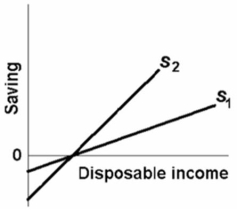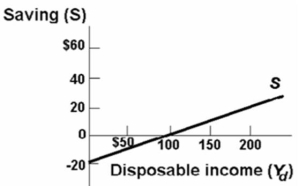A) and APS will both increase.
B) will decrease, but the APS will increase.
C) will increase, but the APS will decrease.
D) and APS will both decrease.
Correct Answer

verified
Correct Answer
verified
Multiple Choice
The consumption schedule shows:
A) that the MPC increases in proportion to GDP.
B) that households consume more when interest rates are low.
C) that consumption depends primarily upon the level of business investment.
D) the amounts households plan or intend to consume at various possible levels of aggregate income.
Correct Answer

verified
Correct Answer
verified
Multiple Choice
For all levels of income to the left of the intersection of the 45-degree line and the consumption schedule, the APC is:
A) greater than 100 percent.
B) less than the APS.
C) equal to the MPC.
D) equal to 100 percent.
Correct Answer

verified
Correct Answer
verified
Multiple Choice
If the inflation rate is 10 percent and the real interest rate is 12 percent, the nominal interest rate is:
A) 2 percent.
B) zero percent.
C) 10 percent.
D) 22 percent.
Correct Answer

verified
Correct Answer
verified
Multiple Choice
Assume that a machine, which has a useful life of only one year, costs $2,000.Also, assume that the difference between the estimated operating costs, which includes power and taxes, and the additional revenue from the output of this machine is expected to be $2,300.If the firm finds that it can borrow funds at an interest rate of 10 percent per annum, the firm should:
A) not purchase the machine because the expected rate of return exceeds the cost of borrowing.
B) purchase the machine because the expected rate of return exceeds the cost of borrowing.
C) not purchase the machine because the cost of borrowing exceeds the expected rate of return.
D) purchase the machine because the cost of borrowing exceeds the expected rate of return.
Correct Answer

verified
Correct Answer
verified
Multiple Choice
Suppose the economy's saving schedule shifts from S1to S2as shown in the below diagram.We can say that its: 
A) MPC has increased.
B) MPS has increased.
C) APS has increased at all levels of disposable income.
D) APS has decreased at all levels of disposable income.
Correct Answer

verified
Correct Answer
verified
Multiple Choice
If the real interest rate in the economy is i and the expected rate of return from additional investment is r, then more investment will be forthcoming when:
A) r is greater than i.
B) i is greater than r.
C) r falls.
D) i rises.
Correct Answer

verified
Correct Answer
verified
Multiple Choice
Following is consumption schedules for three private closed economies.DI signifies disposable income and C represents consumption expenditures.All figures are in billions of dollars.  Refer to the above data.The marginal propensity to save:
Refer to the above data.The marginal propensity to save:
A) is highest in economy (1) .
B) is highest in economy (2) .
C) is highest in economy (3) .
D) cannot be determined from the data given.
Correct Answer

verified
Correct Answer
verified
Multiple Choice
Which of the following is the primary explanation for most of the fluctuations in output and employment over the course of the business cycle?
A) changes in net exports
B) changes in the marginal propensity to consume
C) abrupt changes in stock market prices
D) changes in investment expenditures
Correct Answer

verified
Correct Answer
verified
Multiple Choice
Given the consumption schedule, it is possible to graph the relevant saving schedule by:
A) subtracting the MPC from "one" at each level of income.
B) subtracting investment from consumption at each level of GDP.
C) plotting the horizontal differences between the consumption schedule and the 45-degree line.
D) plotting the vertical differences between the consumption schedule and the 45-degree line.
Correct Answer

verified
Correct Answer
verified
Multiple Choice
A rightward shift of the investment-demand curve might be caused by:
A) an increase in the price level.
B) a decline in the real interest rate.
C) a decline in the acquisition, maintenance and operating costs.
D) an increase in business taxes.
Correct Answer

verified
Correct Answer
verified
Multiple Choice
Which of the following is likely to be an effect of lower business taxes on the investment demand curve of an economy?
A) A leftward shift of the curve
B) A rightward shift of the curve
C) An upward movement along the curve
D) A downward movement along the curve
Correct Answer

verified
Correct Answer
verified
Multiple Choice
If the equation for the consumption schedule is C = 20 + 0.8Y, where C is consumption and Y is disposable income, then the average propensity to consume is 1 when disposable income is:
A) $80
B) $100
C) $120
D) $160
Correct Answer

verified
Correct Answer
verified
Multiple Choice
 The equation for the above saving schedule is:
The equation for the above saving schedule is:
A) Yd = -20 + .8S.
B) Yd = 20 + .2S.
C) S = 20 + .8Yd.
D) S = -20 + .2Yd.
Correct Answer

verified
Correct Answer
verified
True/False
The greater the MPC, the greater the multiplier.
Correct Answer

verified
Correct Answer
verified
Multiple Choice
The MPC for an economy is:
A) the slope of the consumption schedule or line.
B) the slope of the savings schedule or line.
C) 1 divided by the slope of the consumption schedule or line.
D) 1 divided by the slope of the savings schedule or line.
Correct Answer

verified
Correct Answer
verified
Multiple Choice
The following table illustrates the multiplier process in a private closed economy:  Refer to the above table.The change in income in round two will be:
Refer to the above table.The change in income in round two will be:
A) $4
B) $16
C) $20
D) $24
Correct Answer

verified
Correct Answer
verified
Multiple Choice
One can determine the amount of consumption at any level of total income by:
A) multiplying total income by the slope of the consumption schedule.
B) multiplying total income by the APC.
C) subtracting the MPS from total income.
D) multiplying total income by the MPC.
Correct Answer

verified
Correct Answer
verified
Multiple Choice
 Refer to the above data.At the $200 level of disposable income:
Refer to the above data.At the $200 level of disposable income:
A) the marginal propensity to save is 21/2 percent.
B) dissaving is $5.
C) the average propensity to save is .20.
D) the average propensity to consume is .80.
Correct Answer

verified
Correct Answer
verified
Multiple Choice
 Refer to the above data.At the $100 level of income, the average propensity to save is:
Refer to the above data.At the $100 level of income, the average propensity to save is:
A) .10.
B) .20.
C) .25.
D) .90.
Correct Answer

verified
Correct Answer
verified
Showing 61 - 80 of 200
Related Exams